Antares is the brightest star in the constellation of Scorpius and on average the fifteenth-brightest star in the night sky. It is, in fact, a binary star.
Key Facts & Summary
- Antares is a slow irregular variable star that ranges in brightness from an apparent magnitude of +0.6 to +1.6.
- It is classified as a red supergiant of spectral type M1.5lab-lb.
- It is often referred to as the “heart of the scorpion” since it is situated at the center of the Scorpius constellation.
- It has a mass of about 12 times that of the Sun, if placed in the center of our Solar System, it would reach somewhere between the orbits of Mars and Jupiter.
- Antares is the brightest, most massive, and most evolved stellar member of the nearest OB stellar association, the Scorpius-Centaurus Association.
- Antares is about 550 light-years away from the Sun.
- It is around 12 million years old and it is already nearing the end of its lifespan. It is expected to explode as a supernova in the next million years.
- Antares is a two-star system consisting of Antares A – the red supergiant, and Antares B – a much smaller yet hotter blue-white main-sequence star of magnitude 5.5, spectral type B2.5V.
- Antares B is 10 times more massive than our Sun, and about 150 times brighter. Antares A, on the other hand, is 10.000 times brighter than the Sun.
- Antares is 4.57 degrees south of the ecliptic thus it can be occulted by the Moon. This happened in 2009 while every year around December 2, the Sun passes 5 degrees north of Antares.
- Planets can also occult Antares, though, with the exception of Venus, this hasn’t happened for millennia.
The Ancient Greeks named Antares “rival to Ares” (opponent to-Mars), due to the similarity of its reddish hue to that of Mars. This comparison may have originated with early Mesopotamian astronomers.
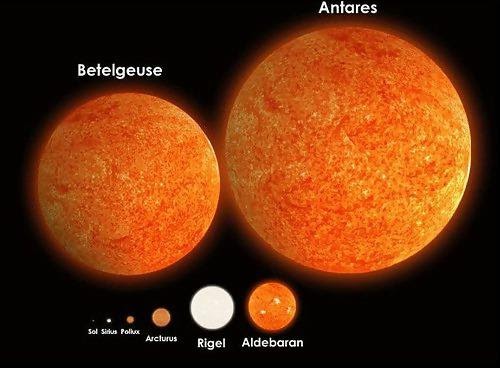
Some believe that the star may have been named after Antar, an Arab warrior-hero celebrated in the pre-Islamic poems Mu’allaqat. The star is visible all night around May 31 of each year. The radial velocity variations of Antares were observed in the early 20th century.
Only in 1952, variations in its brightness were reported. However, researches recently published demonstrated that the Ngarrindjeri Aboriginal people from South Australia observed this variability much sooner.
They incorporated this phenomenon into their oral traditions as Waiyungari, meaning “red man.”
Formation
A cold grouping of dust and gas in space – nebula – resulted in the creation of Antares. Gravity pulled the nebula together and it became a dense cloud of gas. The dense regions collapsed and formed a protostar. As the gas contracted, the temperatures raised until it became so hot, that nuclear fusion could occur. This happened around 12 million years ago.
Distance, Size, and Mass
Antares is about 550 light-years away from the Sun being the brightest star in the constellation of Scorpius. It is about 10.000 times brighter than the sun with a luminosity of about 60.000 times greater. Its estimated radius is about 850 times the radius of the sun or about 3 AU, with a diameter of about 735 million mi / 1.2 billion km.
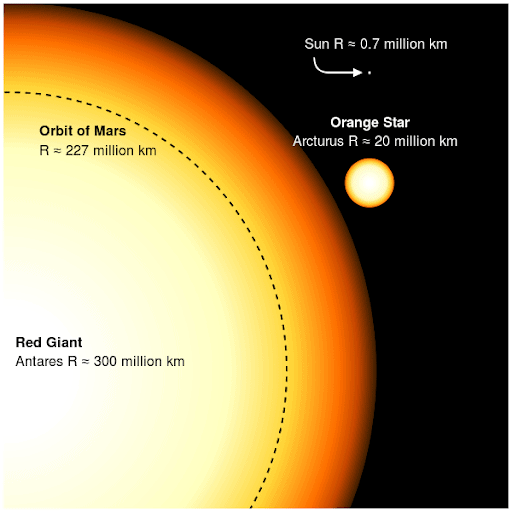
Its estimated surface temperature is much cooler than our Sun, at around 3.000 degrees Celsius / 5.400 degrees Fahrenheit. Its exact mas is yet to be concluded, calculations put it between 12-18 times the mass of our Sun. Though, Antares is rapidly losing mass as a result of a strong wind.
Antares radiates a lot of its energy in the infrared part of the spectrum, the star’s bolometric luminosity is considerably greater than expected, about 65,000 times that of the Sun.
The star is moving through the Milky Way Galaxy at a speed of 20.7 km / 12.8 mi – per second – relative to our Sun. The star’s projected galactic orbit takes it between 20,400 and 23,900 light-years from the Milky Way’s center.
Antares B
Though Antares A was known to the ancients, its companion Antares B was “fairly recently” discovered in comparison. The smaller star was discovered by the Austrian astronomer Johann Tobias, in 1819 during a lunar occultation. However, the star’s existence was not confirmed until 1846.
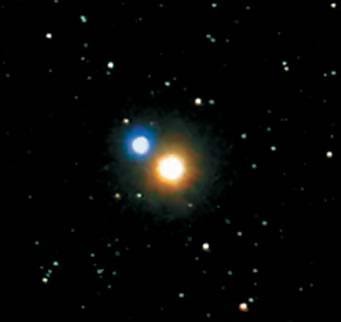
Antares B is a bluish-white 5th magnitude star that lays only about 3 arcseconds away from Antares A. It is hidden in the light of the larger star. Antares B has numerous unusual spectral lines suggesting it has been polluted by matter ejected by Antares A.
Antares B belongs to the spectral class B2.5 and has a visual magnitude of 5.5, which means that it is 370 times dimmer than Antares A, but 150 to 170 times brighter than our Sun. Antares B has a mass of about 7 times that of the Sun. The smaller star has been described as being green, but this may be the result of a contrast effect.
Stellar System
The two stars form a binary system and are separated by around 550 AU. They have an orbital period of about 2,500 years.
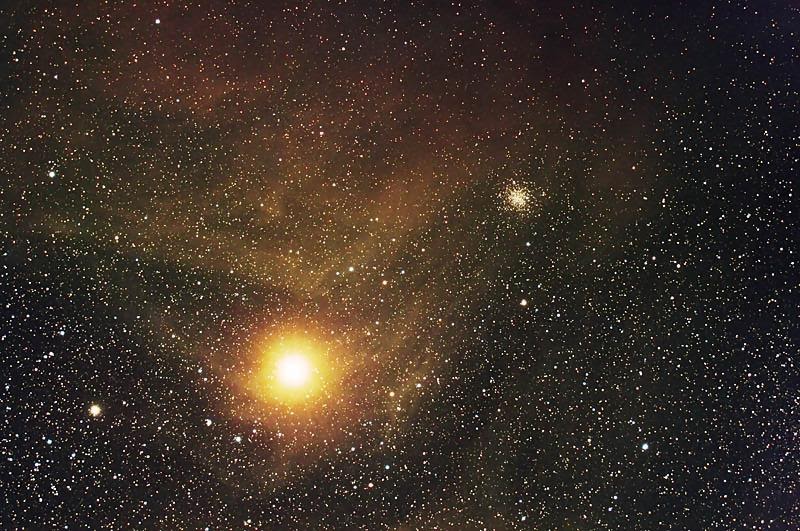
Location
Antares is the most evolved star in the Scorpius-Centaurus Association, a nearby OB association, a group of stars that share a common proper motion through space.
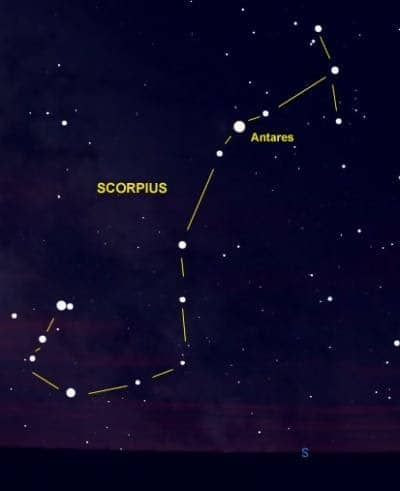
Antares is the brightest and most massive member of the group. It belongs to the Upper Scorpius subgroup of the larger association.
The Scorpius-Centaurus Association contains thousands of stellar members with an estimated age of 11 million years, located at a distance of about 470 light-years / 145 parsecs.
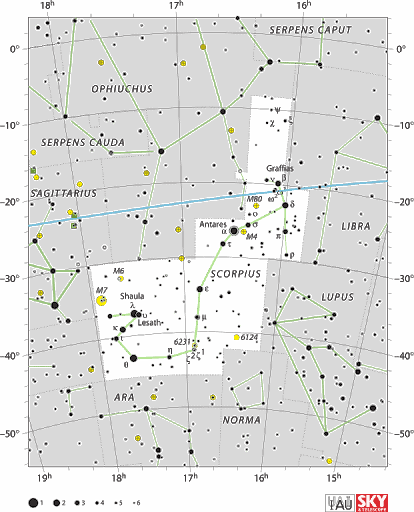
The Future
Lunar occultations of Antares are fairly common. The next cycle will begin in 2023. Antares can also be occulted by planets such as Venus, though it is very rare. Antares is nearing the end of its life and is expected to explode as a supernova within the next million years. This will cause an immense supernova explosion, ultimately leaving a tiny neutron star or possibly a black hole. This explosion could happen anytime.
Did you know?
- Venus will be very near Antares in 2117, and every eight years thereafter will pass south of the star.
- Every year around November 30, Antares comes near the Sun. The date may vary from year to year, but it generally falls between November 30 and December 2.
- Antares appears on the flag of Brazil. The flag displays 27 stars, each representing a federated unit of Brazil. Antares represents the state of Piauí.
- Antares is part of a group of stars known as the “Royal Stars of Persia” together with Aldebaran in Taurus, Fomalhaut in Piscis Austrinus, and Regulus of the Leo constellation.
- Antares is similar but a bit larger than another famous red star, Betelgeuse, which lays in the constellation Orion. Betelgeuse however, appears slightly brighter than Antares in our sky.
- The ancient Chinese people of the Shang Dynasty made Antares their national star.
- In ancient Egypt, Antares represented the scorpion goddess Serket and was the symbol of Isis in the pyramidal ceremonies.
- In the Babylonian star catalogs dating from at least 1100 BCE, Antares was called GABA GIR.TAB, “the Breast of the Scorpion.”
Sources:
Image source:
- https://upload.wikimedia.org/wikipedia/commons/f/fc/Antares.jpg
- https://upload.wikimedia.org/wikipedia/commons/thumb/1/15/Redgiants.svg/600px-Redgiants.svg.png
- https://s22380.pcdn.co/wp-content/uploads/Double-Star-Albireo-Jul-2004-341.jpg
- https://en.es-static.us/upl/2016/07/Antares.jpg
- https://en.es-static.us/upl/2012/07/scorpius_antares-e1341173408749.jpeg
- https://upload.wikimedia.org/wikipedia/commons/thumb/3/38/Scorpius_IAU.svg/621px-Scorpius_IAU.svg.png
